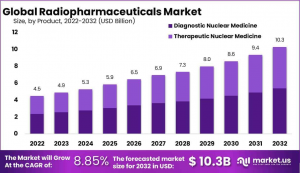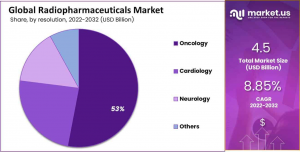Radiopharmaceuticals Market Forecasted to Hit USD 10.3 Billion by 2032 | Product Type, Application, End-User Analysis
Global Radiopharmaceuticals Market size is expected to be worth around USD 10.3 Billion by 2032 from USD 4.9 Billion in 2023, growing at a CAGR of 8.85%
Global Radiopharmaceuticals Market size is expected to be worth around USD 10.3 Billion by 2032 from USD 4.9 Billion in 2023, growing at a CAGR of 8.85% during the forecast period from 2023 to 2032. In 2022, North America led the market, achieving over 47% share with a revenue of US$ 2.1 Billion.
The radiopharmaceuticals market is poised for significant growth, driven by increasing demand for advanced diagnostic and therapeutic solutions. Radiopharmaceuticals, which combine radioactive isotopes with pharmaceutical compounds, are widely utilized in nuclear medicine for imaging and treating various diseases, including cancer, cardiovascular disorders, and neurological conditions. The market is experiencing substantial momentum due to advancements in radiopharmaceutical production technologies and increasing healthcare awareness.
The rise in chronic diseases globally has spurred the adoption of radiopharmaceuticals, particularly in oncology and cardiology. The market is witnessing a shift toward targeted radiotherapy, which enhances treatment precision while minimizing side effects. Moreover, innovations in radiotracers, such as Gallium-68 and Fluorine-18, are revolutionizing diagnostic imaging, providing higher accuracy and efficiency in disease detection.
Key players in the market are heavily investing in research and development to introduce novel radiopharmaceutical products. Collaborations between pharmaceutical companies, research institutions, and healthcare providers are further accelerating innovation. Emerging trends include the integration of artificial intelligence in imaging and the use of theranostic approaches, which combine therapy and diagnostics for personalized medicine.
Regulatory approvals for new radiopharmaceuticals, coupled with increasing government initiatives to improve access to nuclear medicine, are supporting market expansion. The Asia-Pacific region is emerging as a significant growth hub, driven by rising healthcare investments and improved infrastructure for nuclear medicine. The radiopharmaceuticals market holds immense potential to transform diagnostics and therapeutics, offering hope for patients with complex conditions. With continuous innovation and strategic collaborations, the industry is set to achieve robust growth in the coming years.
Unlock Competitive Advantages With Our PDF Sample Report https://market.us/report/radiopharmaceutical-market/request-sample/
Key Takeaways
• Market Size: The global radiopharmaceuticals market is projected to reach USD 10.3 billion by 2032, up from USD 4.9 billion in 2023.
• Market Growth: The market is expected to expand at a compound annual growth rate (CAGR) of 8.85% from 2023 to 2032.
• Type Insights: In 2022, the diagnostic nuclear medicine segment accounted for 52.4% of total revenue.
• Application Insights: The oncology segment leads in application, forecasted to grow at a CAGR of 53% during the 2023–2032 period.
• End-Use Insights: Hospitals and clinics emerged as the dominant segment, holding the largest market share.
• Regional Insights: North America captured the highest revenue share, accounting for 47% in 2022.
• Innovation & Research: Advancements in radiopharmaceuticals are driving the development of highly targeted and effective diagnostic and therapeutic solutions.
• Regulatory Trends: Streamlined regulatory approvals are accelerating the availability of radiopharmaceuticals, contributing to market growth.
• Market Challenges: High costs, limited half-life of radiopharmaceuticals, and stringent safety regulations present ongoing challenges to market expansion.
Market Segments:
Based on Product Type
• Diagnostic Nuclear Medicine
• Therapeutic Nuclear Medicine
Based on Application
• Neurology
• Cardiology
• Oncology
• Others
Based on End-User
• Hospitals & clinics
• Diagnostic Centers
• Other End-users
Immediate Delivery Available | Buy This Premium Research Report@ https://market.us/purchase-report/?report_id=21356
Market Dynamics
Driver: The increasing prevalence of chronic diseases, particularly cancer and cardiovascular disorders, is a primary driver of the radiopharmaceuticals market. Radiopharmaceuticals play a pivotal role in diagnosing and treating these conditions by enabling precise imaging and targeted therapy. Advancements in molecular imaging techniques, such as positron emission tomography (PET) and single-photon emission computed tomography (SPECT), have enhanced the ability to detect diseases at early stages, thereby improving patient outcomes.
The growing adoption of personalized medicine approaches further fuels demand, as radiopharmaceuticals facilitate tailored treatment strategies based on individual patient profiles. Additionally, increased healthcare expenditure and supportive government initiatives contribute to market expansion by promoting research and development in nuclear medicine.
Trend: A notable trend in the radiopharmaceuticals market is the integration of theranostics, which combines diagnostic and therapeutic capabilities into a single platform. This approach allows for the simultaneous detection and treatment of diseases, particularly various cancers, enhancing treatment efficacy and monitoring.
The development of novel radiopharmaceuticals utilizing targeting vectors, such as peptides and antibodies, has improved the delivery of radionuclides to specific lesions, minimizing off-target effects and increasing biosafety. Furthermore, the application of radiotheranostics is expanding beyond oncology to include neurodegenerative and cardiovascular diseases, reflecting a broadening scope of clinical applications.
Restraint: Despite the promising advancements, the radiopharmaceuticals market faces significant challenges, particularly in the supply of critical isotopes. For instance, the production of actinium-225, essential for certain cancer treatments, is limited due to reliance on decaying stockpiles from the Cold War era.
This scarcity hampers the development and availability of new treatments, as pharmaceutical companies struggle to secure sufficient quantities for clinical trials and patient care. Additionally, the high costs associated with radiopharmaceutical production and the stringent regulatory frameworks governing their use pose further obstacles to market growth.
Opportunity: The radiopharmaceuticals market presents substantial opportunities, particularly in the development of targeted alpha therapies (TATs). TATs offer the potential for highly effective treatment of various cancers by delivering potent alpha radiation directly to tumor cells while minimizing damage to surrounding healthy tissue.
Investments in research and development of novel radiopharmaceuticals, as well as advancements in isotope production technologies, are expected to overcome current supply limitations and expand therapeutic options. Moreover, the growing emphasis on personalized medicine and the increasing recognition of radiopharmaceuticals' role in precision oncology further underscore the market's potential for growth and innovation.
Regional Analysis:
North America leads the radiopharmaceuticals market with a 47% share, driven by advanced healthcare facilities, rising chronic diseases like cancer and cardiovascular disorders, and increased research activities. The adoption of advanced radioisotope manufacturing and cyclotron technologies further boosts market growth. Europe follows, supported by regional expansions and mergers.
Asia-Pacific is expected to witness significant growth due to government initiatives, large patient populations, and increasing radiological procedures in countries like India, Japan, and China. Latin America and the Middle East & Africa show potential with rising healthcare expenditures and growing awareness of diagnostic and therapeutic medicines for chronic disease treatment.
Competitive Landscape:
Key players in the AI Voice Generator market are adopting strategic policies to expand operations, enhance R&D, and enter foreign markets. Companies are focusing on product innovation, portfolio expansion, and growth through investments, mergers, and acquisitions. Marketing strategies highlighting natural ingredients are driving product awareness and market growth.
The radiopharmaceuticals market is fragmented, with intense competition among local, regional, and top players with strong brand recognition and distribution networks. To maintain market leadership, companies are pursuing partnerships, product launches, and expansion strategies to strengthen their market position and meet growing consumer demands effectively.
Key Market Players:
• Cardinal Health
• GE Healthcare
• Lantheus Medical Imaging
• Bayer AG
• NTP Radioisotopes
• JSC Isotope
• NorthStar Medical Radioisotopes
• Eckert & Ziegler
• Braun Melsungen AG
• Smith & Nephew plc
• Other key players
Emerging Trends in Radiopharmaceuticals
1. Theranostics Integration: The combination of therapy and diagnostics, known as theranostics, is gaining momentum. Radiopharmaceuticals like Lutetium-177 are used for imaging and treating neuroendocrine tumors, streamlining patient care and outcomes.
2. New Radioisotope Development: Radioisotopes such as copper-64, gallium-68, and actinium-225 are being explored for their dual diagnostic and therapeutic capabilities, expanding the potential of personalized medicine.
3. Advanced Manufacturing Technologies: Cyclotron-based production methods are improving, enabling scalable and cost-effective radioisotope production. This addresses supply challenges and makes radiopharmaceuticals more accessible.
4. Increased Applications in Oncology: Radiopharmaceuticals are increasingly used for prostate cancer and metastatic bone cancers. New therapies, such as PSMA-targeting radioligands, have shown promise in extending survival rates.
5. AI Integration in Radiopharmaceuticals: Artificial Intelligence is being adopted to enhance imaging precision and optimize dosages, leading to more efficient treatments and better patient outcomes.
6. Regulatory Support and Approvals: Governments worldwide are accelerating the approval of innovative radiopharmaceuticals. This trend encourages faster adoption and broader applications in healthcare systems.
Use Cases of Radiopharmaceuticals
1. Cancer Treatment: Radiopharmaceuticals such as Radium-223 treat bone metastases in prostate cancer patients. Clinical studies report improved survival rates and reduced bone pain in over 60% of patients.
2. Cardiac Imaging: Myocardial perfusion imaging uses Technetium-99m to assess coronary artery disease. Annually, over 15 million scans are performed globally, aiding in early diagnosis and treatment planning.
3. Neurological Imaging: Fluorodeoxyglucose (FDG) PET scans are widely used to detect Alzheimer’s disease and epilepsy, with over 2 million scans conducted in the U.S. alone each year.
4. Bone Metastases Pain Management: Samarium-153 relieves pain caused by bone metastases, with significant pain reduction reported in approximately 70% of patients within a few weeks.
5. Thyroid Disorders: Iodine-131 is a gold standard for treating hyperthyroidism and thyroid cancer, with over 90% success rates in disease control and remission.
6. Neuroendocrine Tumors Therapy: Lutetium-177, used in peptide receptor radionuclide therapy (PRRT), has demonstrated tumor size reduction in 30-40% of neuroendocrine cancer patients.
Lawrence John
Prudour
+91 91308 55334
Lawrence@prudour.com
Legal Disclaimer:
EIN Presswire provides this news content "as is" without warranty of any kind. We do not accept any responsibility or liability for the accuracy, content, images, videos, licenses, completeness, legality, or reliability of the information contained in this article. If you have any complaints or copyright issues related to this article, kindly contact the author above.



